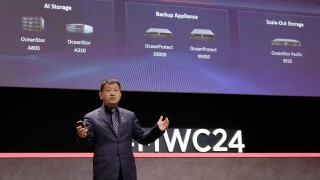If Dan Caruso, the enigmatic co-founder, president and CEO of Zayo Group ever gets tired of answering the same old question, he hides it well. That question – whether he will take his fast-expanding fibre-network business to the US stock market – is asked every time he ventures into the public domain.
One suspects that he finds it somewhat tiresome, yet calmly, patiently, he once again sets out to manage expectations of an imminent initial public offering (IPO). It’s a persuasive patter delivered in the same tones he draws on when meeting potential institutional investors in the public markets.
Caruso speaks like an elder statesman. Among his peers in the metro markets, he has assumed a certain gravitas – an admiration, if you like, born of his determination to debunk the prejudices that still hang over bandwidth infrastructure companies in the wake of the telecoms meltdown.
“He’s very passionate about the metro story,” says one Wall Street insider who knows him well. “I wouldn’t go so far as to say that he’s single-handedly changed the way the public markets value metro fibre providers, but he’s definitely getting there. Let me tell you, there are a lot of folks out there who are sitting on a million reasons to thank him for what he is doing.”
“Ah, yes,” cynics will say at this point. “You would expect a banker seeking Caruso’s eagerly-awaited mandate to flatter, wouldn’t you?” But Caruso’s true value to Wall Street lies in the very compelling investment case he is crafting, not just for Zayo but for the metro sector at large. “He’s putting the metro sector on the map and that’s going to help Sidera and Fibertech if they ever decide to go down the same route,” the banker says.
To Caruso, it’s not so much about trying to win over critics of the industry, but rather, to educate them with the bare facts and let them make up their own minds: “I don’t want to repeat the mistakes that our industry made in the past. I want to show people the hard numbers and offer very clear visibility about how our business is performing so that potential investors can assess for themselves how to value us, and perhaps more importantly, what the opportunities are.”
This, one feels, is not said to provoke his detractors, but to engage with them: “I welcome specific feedback from those who are sceptical of Zayo’s performance – it might help us fine tune our business model.”
The company provides bandwidth, co-location, voice and managed services to carriers, enterprise and government agencies in 153 markets and 30 states across the US. The business is divided up into separate units covering bandwidth infrastructure, co-location, fibre networks and enterprise solutions and customers include a broad array of wireless service providers, enterprise and government agencies.
Zayo Bandwidth, the largest unit in terms of revenue, already boasts more than 4,000 buildings on a fibre network extending more than 22,000 route miles and linking 60 separate metro markets. The network, which also hosts more than 1,700 on-net towers is optimised to provide a range of fibre-based services, including low latency and Ethernet offerings. Through its zColo subsidiary, meanwhile, third-party networks can exchange voice, video, data and internet traffic at interconnection facilities in New York and New Jersey. A third unit, Zayo Fiber Solutions, provides dark-fibre bandwidth infrastructure services, while Zayo Enterprise Networks aims to sell network services to a broad array of hospitals, schools, businesses and government agencies.
Across the entire group, Caruso demands an open-door transparency that would put some listed companies to shame. Last year, the CEO took an even bolder step, publishing a steady stream of quarterly earnings reports that did not stint on hard detail – customer churn rates, capital expenditure breakdowns, details of on-tower and on-net numbers. It’s all there to read. “The whole reason we disclose more complete financial data is to allow more fact-based discussion about the merits of the bandwidth infrastructure business,” he comments.
Ironically, of least value are the headline financials themselves. Such has been the pace of acquisition that like-for-like comparisons are all but meaningless. Caruso prefers a measurement called the invested capital ratio. The ratio is calculated by dividing the amount of money his backers have invested in the business ($461 million as of September 30 2010) by Zayo’s annualised adjusted EBITDA ($106 million for the three months ending last September). That gives a ratio of 4.3x, against a group valuation which independent analysts conservatively put at 8 to 10x EBITDA. In other words, Caruso has more than doubled his original backers’ money in the five years since he founded the business.
Caruso is happy to let the numbers do the talking. If there is a corporate message at Zayo, it is that financial transparency is a good thing: “I think it is a clear priority for 2011, not just for us but for the metro fibre market as a whole. If you go out and talk to public investors – and by the way I do, by the dozen – too many of them still view bandwidth telecoms as if the telecoms meltdown persists. We saw this clearly in the M&A activity of 2010. I call this the telecoms hangover. Now it’s up to all of us to help the public markets understand the investment merits of bandwidth infrastructure.”
To the question of an IPO, then. “I would put the probability of us going down the route of an IPO over the next year at less than 25%,” Caruso says. “It’s something we routinely explore and prepare for, as we do our other financing options. We want to be able to move quickly to tap the right source of capital for the right opportunity at any point in time, as well as to give our sponsors a variety of options for exiting their Zayo investment. Right now, it’s just as likely we’d choose other financing and exit options considering where we are headed.”
The glare of publicity might shine brightly over Zayo’s headquarters in Louisville, Colorado, but it does not distract Caruso from the task in hand: “We learned the hard way that we need to hold ourselves accountable day in, day out for the things that we do to create value in this business. We don’t tend to shift our strategy with the ebb and flow of various fads. We strive to add value over the long-term and we devise our strategy accordingly.”
Zayo’s commitment to dark fibre is a case in point: to some, it’s the boring country cousin of Ethernet backhaul or, worse, a dirty word from the depths of the telecoms meltdown; to Caruso, it’s a low-churn, high-margin licence to generate cash flows.
Clearly, growth through acquisition also remains core to that strategy. Caruso does not expect the current wave of consolidation to abate any time soon, even though much of the low-hanging fruit has been plucked: “There are still a number of smaller players out there who will likely look for an exit in the next year, and we hope to make some fill-in acquisitions at Zayo as the opportunities arise,” he says. But going forward, the bigger play will be among those who are currently doing the consolidating.
A case perhaps of the hunter becoming the hunted? “In the medium term, it’s more about what happens to the network providers that generate EBITDA of, say, $50 million or more. Two years from now, I suspect two or more of those would have combined. Larger telecoms might also become more interested in the larger pure-play bandwidth infrastructure providers.” For now, though, Caruso is content to maximise value for his current stakeholders – and that means anticipating the future needs of customers: “We see continuing demand for fibre-based infrastructure services, and we plan to carry on capturing as much of that as we can. However, we will not chase any and every opportunity, but will instead remain focussed on providing infrastructure services to targeted customers in markets where we have assets to leverage.”
Caruso confidential |
| ... on opportunities in the middle mile: ... on data centres: ...on Ethernet exchanges: ...on the recent departure of long-time partner John Scarano: |
Zayo at a glance |
History: Founded in November 2006 by Dan Caruso, a former veteran of MFS Communications and a founding executive of Level 3, Zayo has grown rapidly through acquisition to become one of the biggest independent fibre network providers in the US. Corporate structure: Split into autonomous business units: Zayo Bandwidth; zColo; Zayo Fiber Solutions; and Zayo Enterprise Networks. Backers: Battery Venture, Centennial Ventures, Charlesbank Capital Partners, Columbia Capital, M/C Venture Partners, Morgan Stanley and Oak Investment Partners. Additional financing: Tapped US bond market with a $250 million offering of senior secured notes due in 2017, carrying a coupon of 10.25%. The issue was extended to $350 million in September 2010. The company can also draw on a $75 million four-year revolving credit facility. Major acquisitions: 16 since 2007, including AGL Networks, American Fiber Systems, Delfini Networks, FiberNet Telecom Group, Columbia Fiber Solutions and Onvoy. Headquarters: Louisville, Colorado. Number of employees: 382 Chief Executive: Dan Caruso, also co-founder and president. Caruso is best known for leading the $8.7 million buyout of ICG Communications, which was sold two years later for $225 million. Network: Consists of around 21,584 route miles (over 753,000 fibre miles) and 3,101 on-net buildings spanning 146 markets in 27 states, as well as the District of Columbia. On-net building breakdown includes 1,300 cell sites and 1,150 enterprise buildings. Products and services: Carrier customers include cable TV companies, LECs, ISPs and telecoms carriers. Enterprise customers include web-centric businesses, healthcare providers, financial services and government entities. Product lines include private line, Ethernet, dark fibre, wavelength, internet and network neutral co-location services. |








